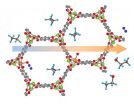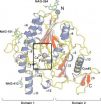(Press-News.org) This gift from science just keeps on giving. Measurements taken at the National Institute of Standards and Technology (NIST) show why a material already known to be good at separating components of natural gas also can do something trickier: help convert one chemical to another, a process called catalysis. The discovery is a rare example of a laboratory-made material easily performing a task that biology usually requires a complex series of steps to accomplish.
The material is a metal-organic framework (MOF), one of a class of substances whose porosity, high surface area and tunable properties make them promising for applications such as gas storage and drug delivery. This particular iron-based MOF, which the research team refers to as Fe-MOF-74,was built in the lab of Jeffrey Long, a professor of chemistry at the University of California Berkeley, who also has patented it.*
Having learned two years ago** that Fe-MOF-74 could effectively separate closely related components of natural gas from one another, this time Long's collaborators at the NIST Center for Neutron Research (NCNR) looked at its power to catalyze reactions—that is, accelerate or enable the chemical reaction of two other materials. In this case, they turned ethane,a component of natural gas, into ethanol, a component of vodka. The research team knew that the iron in the MOF could change from possessing one number of electrons to another, which raised interesting questions.
"One of the big long-term goals of biochemistry is to build things with specific functions from the ground up," says the NCNR's Craig Brown. "It's hard to simply make things like nature does, because she often converts one material into another in a fiendishly complex way. But with a MOF that can mimic nature's effect, we might be able to make the same thing, but right in the lab and far more easily."
While the MOF was great at catalyzing the reaction, the team wasn't sure why. The search for understanding led to two (fairly technical)discoveries at the NCNR: the importance of the MOF's iron for catalysis, and the reason the oxidizer worked so well.
Iron being able to change its number of electrons is the key to creating a high-yield catalytic process. When the team substituted magnesium for 10 percent of the iron in the MOF, the reaction produced 40 percent less ethanol than before. The NCNR's neutron diffractometer helped clarify why, and they also showed that the oxidizer—nitrous oxide, a lopsided molecule with oxygen at one end and two nitrogen atoms at the other—must connect its oxygen end to the iron in the MOF for catalysis to occur.
Brown says exploring the catalytic behavior in this material may reveal other ways to use MOFs to mimic what biology can do. "We hope to get more insights into the reactivity of this material and possibly the design, synthesis and catalytic activities of other MOFs," he says.
INFORMATION:
*D.J. Xiao, E.D. Bloch, J.A. Mason, W.L. Queen, M.R. Hudson, N. Planas, J. Borycz, A.L. Dzubak, P. Verma, K. Lee, F. Bonino, V. Crocellá, J. Yano, S. Bordiga, D.G. Truhlar, L. Gagliardi, C.M. Brown, J.R. Long. Oxidation of ethane to ethanol by N2O in a metal–organic framework with coordinatively unsaturated iron(II) sites. Nature Chemistry, DOI 10.1038/nchem.1956,May 18, 2014.
**See the April 2012 NIST Tech Beat story, "Novel Filter Material Could Cut Natural Gas Refining Costs" at http://www.nist.gov/public_affairs/tech-beat/tb20120403.cfm#filter.
From separation to transformation: Metal-organic framework shows new talent
2014-05-22
ELSE PRESS RELEASES FROM THIS DATE:
Don't blink! NIST studies why quantum dots suffer from 'fluorescence intermittency'
2014-05-22
Researchers at the National Institute of Standards and Technology (NIST), working in collaboration with the Naval Research Laboratory, have found that a particular species of quantum dots that weren't commonly thought to blink, do.
So what? Well, although the blinks are short—on the order of nanoseconds to milliseconds—even brief fluctuations can result in efficiency losses that could cause trouble for using quantum dots to generate photons that move information around inside a quantum computer or between nodes of a future high-security internet based on quantum telecommunications.
Beyond ...
Putting a number on opinion dynamics in a population
2014-05-22
Philadelphia, PA—Opinion formation in a large population is influenced by both endogenous factors, such as interaction with one's peers—in-person and via social media—as well as exogenous factors, such as the media, of which mainstream media is one of the most influential factors. For example, according to a study conducted by the National Bureau of Economic Research in 2006, after the introduction and expansion of Fox News in the United States between 1996 and 2000, an estimated 3-28% of the audience was persuaded to vote Republican.
In a recent paper published in ...
NIST chip produces and detects specialized gas for biomedical analysis
2014-05-22
A chip-scale device that both produces and detects a specialized gas used in biomedical analysis and medical imaging has been built and demonstrated at the National Institute of Standards and Technology (NIST). Described in Nature Communications,* the new microfluidic chip produces polarized (or magnetized) xenon gas and then detects even the faintest magnetic signals from the gas.
Polarized xenon—with the atoms' nuclear "spins" aligned like bar magnets in the same direction—can be dissolved in liquids and used to detect the presence of certain molecules. A chemical interaction ...
NCNR neutrons highlight possible battery candidate
2014-05-22
Analysis of a manganese-based crystal by scientists at the National Institute of Standards and Technology (NIST) and the Massachusetts Institute of Technology (MIT) has produced the first clear picture of its molecular structure. The findings could help explain the magnetic and electronic behavior of the whole family of crystals, many of which have potential for use in batteries.
The family of crystals it belongs to has no formal name, but it has three branches, each of which is built around manganese, cobalt or iron—transition metals that can have different magnetic ...
Bending helps to control nanomaterials
2014-05-22
A new remedy has been found to tackle the difficulty of controlling layered nanomaterials. Control can be improved by simply bending the material.
The mechanism was observed by Academy Research Fellow Pekka Koskinen from the Nanoscience Center of the University of Jyväskylä together with his colleagues from the University of Massachusetts Amherst in the US. Bending decreases interaction between layers, making the material merely a stack of independent atomic layers.
The group investigated the van der Waals nanomaterials which consist of stacked and loosely bound two-dimensional ...
Safety in numbers: Moderate drinking in a group reduces attraction to risk
2014-05-22
New research led by the University of Kent shows that individuals who have consumed moderate amounts of alcohol in social situations are likely to view risky situations with greater caution when considering them as part of a group.
The research, by psychologists from the University of Kent and the University of East Anglia, produced the first evidence found outside of laboratory conditions that being in a group can reduce some effects of alcohol consumption. The findings could lead to the design of new interventions designed to promote safer recreational drinking.
Researchers ...
Scientists provide insight into the pathology of Sanfilippo A syndrome
2014-05-22
Sanfilippo A syndrome or Mucopolysaccharidosis IIIA (MPS-IIIA) is a rare genetic lysosomal storage disease inherited from the parents of the patient. Lysosomes are the body's vehicle for breaking down many of its by-products such as proteins, nucleic acids, carbohydrates, lipids and cellular debris. The spherical vesicles are known to contain 50 different enzymes which are all active around an acidic environment of about pH 5.
Whilst each lysosomal disorder results from different gene mutations that translate into a deficiency in enzyme activity, they all share a common ...
Marriage of convenience with a fungus
2014-05-22
This news release is available in German. Thanks to a fungus, the medicinal plant ribwort plantain gains a higher concentration of the defensive compound catalpol. Biologists at Bielefeld University report this discovery in a study to be published this Thursday (22.5.2014) in the scientific journal 'Nature Communications'. The increase in catalpol gives the plant better protection against pests. In the study, the research team worked with arbuscular mycorrhizal fungi. These are known to colonize the roots of land plants. The plants benefit from this, because the fungus ...
Stem-cell research: A new genetic switching element
2014-05-22
Slight modifications in their genome sequences play a crucial role in the conversion of pluripotent stem cells into various differentiated cell types. A team at Ludwig-Maximilians-Universitaet (LMU) in Munich has now identified the factor responsible for one class of modification.
Every cell contains stored hereditary information, encoded in the sequence of nucleobases that make up its DNA. However, in any given cell type, only a fraction of this information is actually used. Which genes are activated and which are turned off is in part determined by a second tier of ...
Low-carb vegan diet may reduce heart disease risk and weight
2014-05-22
TORONTO, May 22, 2014 -- Researchers at St. Michael's Hospital have shown for the first time that, in addition to weight loss, a specific low-carbohydrate diet may also reduce the risk of heart disease by 10 per cent over 10 years.
The diet, often called Eco-Atkins, is a low-carbohydrate vegan diet. Many low-carbohydrate diets have been proven to improve weight loss but most emphasize eating animal proteins and fats, which may raise cholesterol. Diets that are high in vegetable proteins and oils may reduce the risk of heart disease by lowering "bad cholesterol."
"We ...




